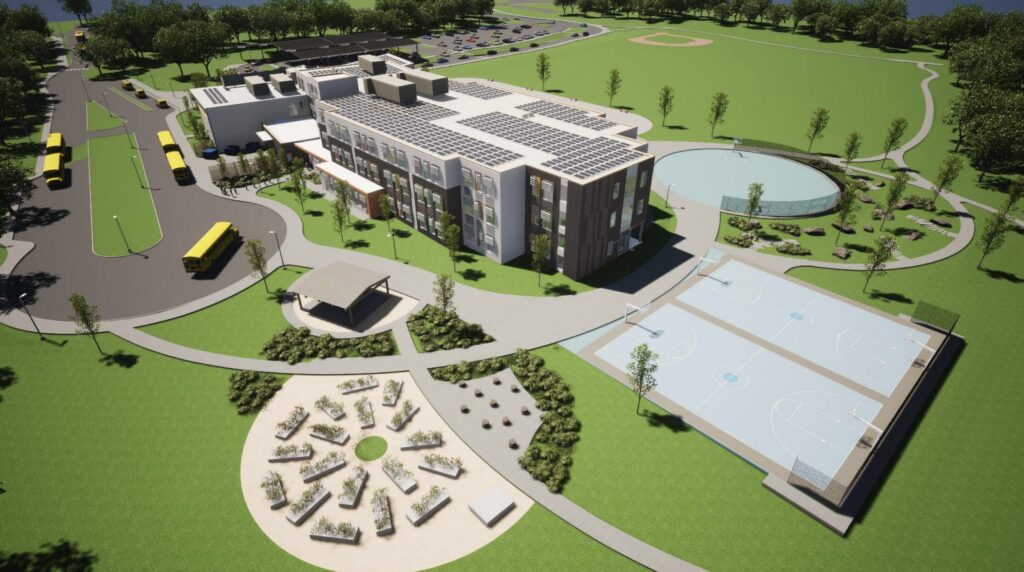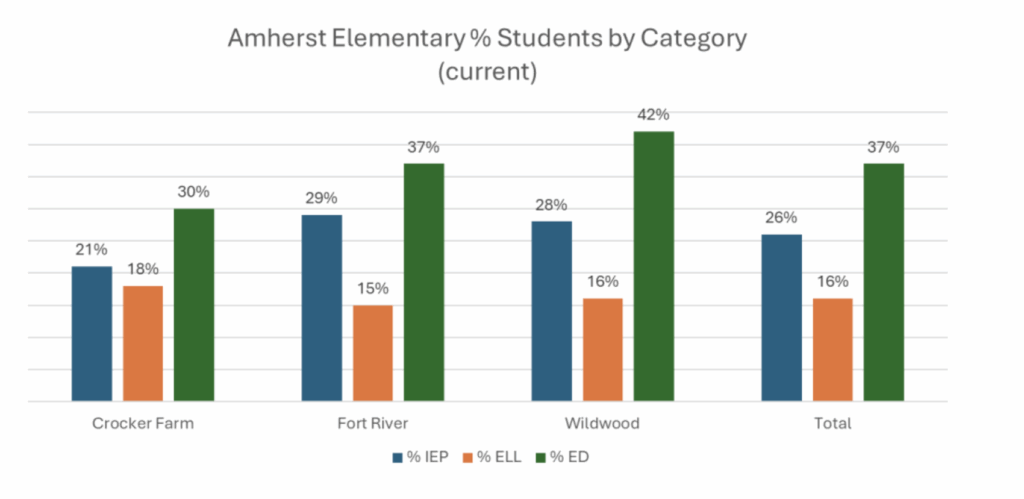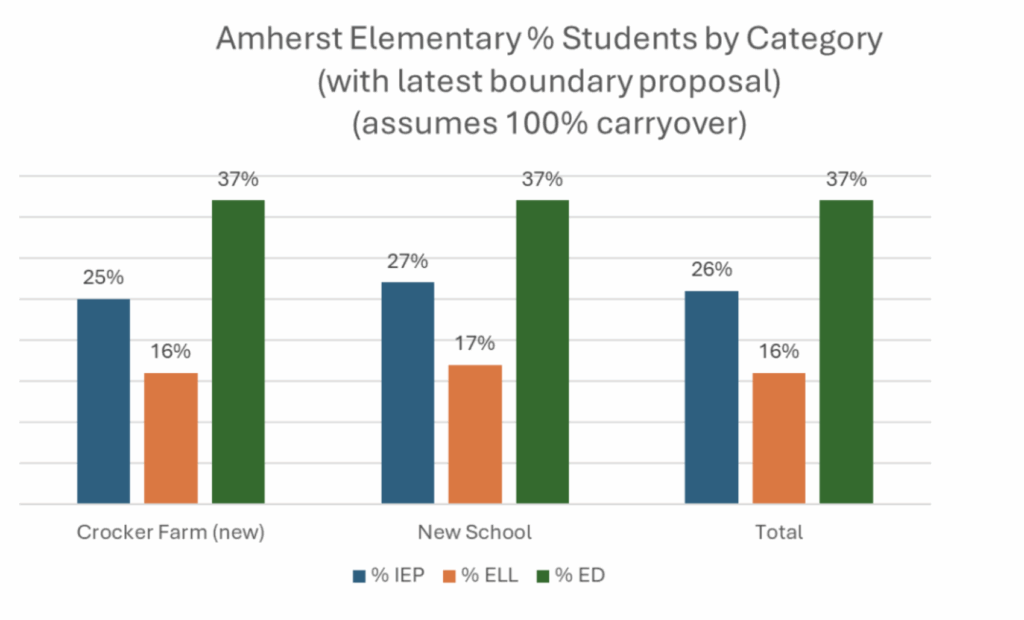New Boundary Zones for Amherst Elementary Schools

Architect's rendering of the new elementary school at Fort River. Aerial view from Southeast. Photo: amherstma.gov
Jennifer Shiao’s School Committee Blog
Editor’s note: . Jennifer Shiao is a member of the Amherst School Committee. Her original posts can be found here. An archive of her blog posts in The Indy can be found here.
Notice: Public Forum on Amherst Elementary boundary zones: Monday, November 17, 5:00 pm, via Google Meet.
With the start of the 2026-27 school year, the Amherst Elementary School District will look quite different from what it looks like today. Two significant changes will be implemented:
- The Wildwood and Fort River school buildings will be closed, and in their place a new school building will open on the Fort River site, which will hold students in grades K through 5. The Crocker Farm school will remain in operation, also as a K through 5 school (plus the Early Education Center preschool).
- All 6th grade students in Amherst will attend school at the Amherst Regional Middle School (ARMS). It’s important to note that these students will not be enrolled at ARMS; rather, they will be Amherst Elementary students who will attend school in the ARMS building. More information about this topic will be available in the coming months.
As a result of this restructuring, the district needs to define the boundary zones for the new school and for Crocker Farm. It’s not quite as simple as combining the current Wildwood and Fort River zones for the new school, and keeping the Crocker Farm zone the same as it currently is, for two main reasons:
- Crocker Farm will be taking a slightly larger portion of K-5 students than it currently has.
- The current boundary zones include two “islands” within the Crocker Farm zones – these islands are two apartment complexes that are zoned to Wildwood and Fort River, despite being within the Crocker Farm zone. The decision to create these two islands was made by the School Committee in place when these zones were determined.
The district has engaged Tim Ammon from Ammon Consulting, a firm with a great deal of experience in this type of work for school districts, to propose new boundary zones. Here is the latest draft proposal of the boundary zones from Ammon, from the October 24 Amherst School Committee meeting.
See slide 6 for a map which displays the current and proposed boundaries. The thick black lines represent the current boundaries – the northwest zone is Wildwood, the east zone is Fort River, and the southwest zone is Crocker Farm. The large colored areas represent the latest proposed boundaries for the new school and Crocker Farm. Some important things to note:
- The superintendent has stated that any students who would be affected by these boundary changes will have the option to remain in their current school, and younger siblings will be handled on a case-by-case basis.
- The peach and light blue areas inside the Crocker Farm zone (purple) are the “islands” which are currently zoned to Wildwood and Fort River. In the proposal, these islands would change to be zoned to Crocker Farm. (They are colored on slide 6 in order to highlight them, but they are Crocker Farm/purple.)
- The area just north of the purple/Crocker Farm zone are streets/neighborhoods which are currently zoned to Crocker Farm and would change to the new school. This area includes all of the side streets between Amity St. and Northampton Rd (Rte 116/9). It also includes Woodside, Hitchcock, and Snell St. and side streets.
- Another change would occur on the northern portion of the border between Crocker Farm and the new school. The homes along Southeast St., as well as Valley View Circle and Valley View Dr., are currently zoned to Fort River, and would change to Crocker Farm.
Whenever new zones are proposed, it’s important to look at the resulting demographic makeup of the schools. The main categories of demographics that we can look at are: race/ethnicity, presence of IEP (individualized education program), English language learner, and economically disadvantaged.
”Economically disadvantaged” is a measure defined by DESE (Department of Elementary and Secondary Education) based on a student’s participation in one or more of the following state-administered programs: the Supplemental Nutrition Assistance Program (SNAP), the Transitional Assistance for Families with Dependent Children (TAFDC), the Department of Children and Families’ (DCF) foster care program, and MassHealth (Medicaid).
It’s important to note that no group is a monolith, and within every group of people that have a common characteristic there is a wide spectrum of ability, resources, needs, and more.
First, let’s talk about race/ethnicity. Here is the current make-up of our three elementary schools as well as the total elementary district.

Each bar represents the % of students in that category in that school. For each school and the total, the figures add up to 100 (could be one point off due to rounding). Here are some things that I see when I look at this data:
- Around half of our elementary students are White. This is slightly lower in Wildwood, where there is a higher portion of Asian students.
- At Fort River, Hispanic or Latino students represent 1 in 5 students (21%), which is higher than the overall figure of 14%, likely due to the presence of the Caminantes program in that school.
- At Wildwood, Asian students represent 1 in 5 students, which is higher than the overall figure of 13%. My best guess is that this is likely due to UMass family housing in the Wildwood zone, which may skew towards more Asian graduate students.
- Our schools are not identical when it comes to racial make-up, and each has its own personality and strengths.
Here is the projected make-up of students in Crocker Farm and the new school, based on the current student population and the latest boundary proposal:

It’s important to note that this data reflects the assumption that all students who would be affected by the new boundary proposal would opt to stay in their current school. In reality, we don’t yet know how many or which students will opt to carry over in their current school. Please also note that these figures are different from what was reported in the Ammon presentation from the October 24 Amherst School Committee meeting; the figures in that presentation did not account for carry-over students.
There are still variances between the two schools:
- The new school would have a larger portion of Hispanic or Latino students than Crocker Farm, again likely due to the presence of the Caminantes program.
- The new school would have a larger portion of Asian students (14%) compared to Crocker Farm. Again, my best guess is that this is due to UMass student family housing in the zone for the new school.
- Crocker Farm will have a larger portion of Black or African American students than the new school, by 2 percentage points.
Next, let’s look at three important categories: Students with IEPs, English language learners (ELL), and economically disadvantaged (ED) families.
Here is the current make-up of our schools:

Each bar represents the % of students in that category in that school. Unlike the race/ethnicity data, the bars do not add up to 100%; the same student can be counted in more than one category and some students are not captured in any of the categories.
What this data tells me is that we currently have variances in these groups of students at our three schools.
- At Wildwood, there is a larger portion of students from families designated as “economically disadvantaged.”
- At Crocker Farm, there is a smaller portion of students with IEPs, likely due to the presence of specialized special education programs at the other schools.
- At Crocker Farm, there is also a larger portion of English language learners.
- Yet again, our schools are not identical when it comes to these categories, and each has its own personality and strengths.
Here is the projected make-up of students in Crocker Farm and the new school, based on the current student population and the latest boundary proposal:

Again, it’s important to note that this data reflects an assumption that all students who would be affected by the new boundary proposal would opt to stay in their current school. In reality, we don’t yet know how many or which students will opt to carry over in their current school.
When comparing each category between Crocker Farm and the new school, the projected compositions are more similar than currently.
So what does all of this mean and where does it leave us? Here is my current thinking:
- We know that we need to define boundary zones for the new school and Crocker Farm.
- Ideally, we would do this in a way that impacts as few students as possible – meaning that we minimize students changing schools. This is partially addressed by the superintendent’s announcement that any student who would be affected by the new boundary zones can opt to stay in their current school (and younger siblings would be handled on a case-by-case basis).
- Ideally, we would not continue to have “islands” of students sent to a school outside their zone. In my opinion, carving out islands within one school’s boundary zone, in order to create some desired “balance” is not a best practice, and it may marginalize the students in the islands.
- Essentially, we need to draw one unbroken line through our town, in order to create two school zones, with the number of students in each zone aligning with the schools’ capacities. The chances of doing that AND having the two schools be identical in demographic make-up are pretty low. That being said, it’s my opinion that the latest boundary proposal gets pretty close.
- Bottom line – the latest boundary proposal minimizes the number of students affected by the new zones AND results in two schools that are pretty similar in their demographic make-up. Said another way – the variances in the demographics between the two schools is acceptable, imho.
Members of the public are invited to give input at the Public Forum on Amherst Elementary Boundary Zones on Monday, November 17, 5pm – 7pm. This will be an all virtual meeting.
This blog reflects my own views about the Amherst and Amherst-Pelham Regional School Committees – it does not represent the view of the committees, the district, or the superintendent. This blog complies with Open Meeting Law, as long as a quorum of School Committee members do not engage in deliberations in the comments. Comments are welcome. I may respond to comments, but I will not respond to all comments. Sign up here using the “follow blog via email” form to be notified when I post a new entry. You can email me at jennifer@jenniferamherst.org.
